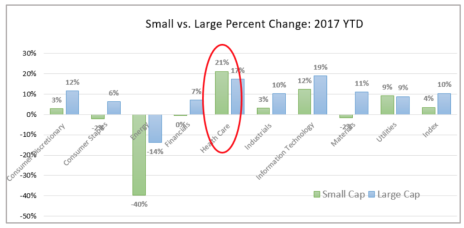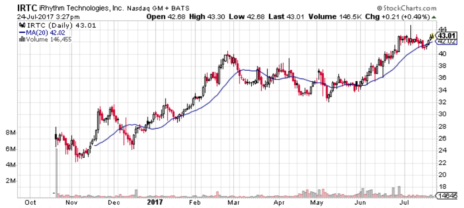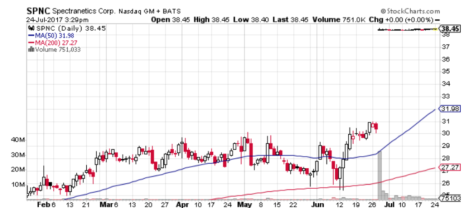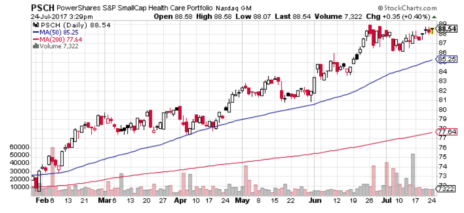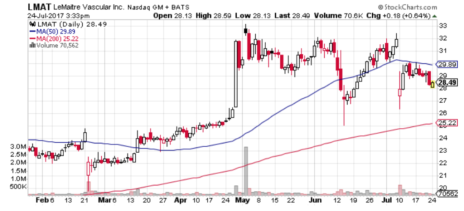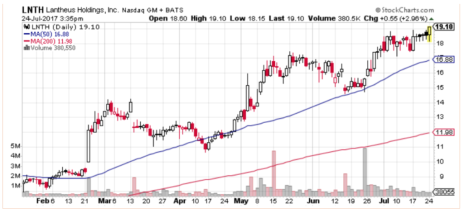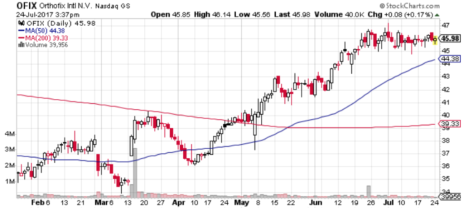GOP Health Care Bill Doomed, But Stocks Soaring
Given the debate around healthcare and the on again-off again effort to repeal and replace Obamacare, it may come as a surprise that small-cap healthcare stocks are the best performing sector this year. The small-cap sector’s 21% rise is nearly 10% greater than that of the next best performing small-cap sector, technology. And it’s even better than the best performing large-cap sectors, including technology (up 19%), and large-cap healthcare (up 17%).
What gives? Why are small-cap healthcare stocks soaring even while the future of the U.S. healthcare market is so unknown?
The simplest (and therefore, most likely) answer is that ever since provisions of Obamacare went into effect, these stocks have been doing well because they’ve been operating in a relatively friendly environment. And perhaps, even amid the controversy and political posturing surrounding Republican efforts to replace the ACA, healthcare companies are adapting in ways that will allow them to grow, despite policy uncertainty.
[text_ad]
Admittedly, that explanation lacks specificity. But given that the small-cap healthcare sector spans medical devices, biotech, pharmaceuticals, healthcare providers and healthcare services, and that each of these sub-sectors has different pricing, regulatory and competitive dynamics, any non-company specific explanation for the strength must be broad.
A more granular level explanation must delve into the 14 major repeal elements of proposed Republican bill. The big ones include the medical device tax (a 2.3% tax that was already suspended for two years starting in 2016), investment tax (3.8% tax with household income over $250,000 for married and over $200,000 for single filers), tanning tax (10% on sales of indoor tanning), Additional Medicare Tax (0.9%, same thresholds as investment tax), the health insurance fee (HIF fee paid by insurers, already suspended for 2017), and the tax on brand pharmaceutical manufacturers, all of which Republicans proposed repealing as of the beginning of 2018. Also on the table was an end to Medicaid’s expansion funding, beginning in 2021 with a three-year phase out. And then of course there’s corporate tax reform, which could hit healthcare-related companies in different ways.
At this point I must quote Trump. Man, nobody knew healthcare could be so complicated!
We can’t get into details of all these elements today. And the optimist in me is saying we don’t need to bother. The market is telling investors not to be overly concerned with the healthcare debate.
Maybe it’s wrong. But then, maybe it’s not.
3 Small-Cap Medical Device Stocks to Buy Now
The Centers for Medicare & Medicaid Services (CMS) sees national healthcare spending rising at an average annual rate of 5.6% through 2025, ultimately reaching 20% of GDP.
Amid that backdrop, examples of continued interest in small-cap healthcare stocks abound, both by investors and by companies on the prowl for accretive acquisitions. Look at the performance of iRhythm Technologies (IRTC) since it went public at $18 last October. It’s up over 125% since.
The maker of wearable ECG monitors isn’t the only one in the heart disease market that’s attracted attention. Just a couple of weeks ago Philips (PHG) took out Spectranetics (SPNC) at a 27% premium to its prior close. Spectranetics makes devices used in minimally invasive procedures in the cardiovascular system, is growing revenue in the double digits, and was in a solid uptrend when Philips agreed to the $2.2 billion price tag.
The easiest way to gain exposure to small-cap healthcare stocks is undoubtedly with the PowerShares S&P SmallCap Health Care ETF (PSCH). I check on this ETF a couple of times a week as part of my broad market review. The passively managed fund’s 80 stock exposure, 0.29% expense ratio and tilt toward growth (73% growth, 17% value and 11% blend) is hard to beat for those seeking an all-in-one small-cap healthcare play. I also like that it’s well diversified across medical equipment (33% of holdings), healthcare services (27%), biotech (21%) and pharmaceuticals (20%).
If you’re looking to buy individual stocks, you would be well served to peek inside this small-cap healthcare ETF and see what’s working and what suits your criteria. Or read on, because I did that work for you!
One of the areas of healthcare that appeals to me is the medical equipment space. While I like the biotech stocks and pharmaceuticals, I know that, especially with small caps, there is so much uncertainty related to drug efficacy and regulatory approvals that it’s challenging to consistently hit singles and doubles, let alone triples and home runs.
In contrast, many medical equipment stocks offer long-term revenue and EPS growth potential, with far less downside risk.
Here are three from the S&P SmallCap Health Care ETF that jump out at me based on their business models, charts, growth rates and risk/stability profiles.
Small-Cap Healthcare Stock #1: LeMaitre Vascular (LMAT)
LeMaitre Vascular develops and sells a wide variety of medical devices for treating peripheral vascular disease. The company went public in 2006, has a market cap of $535 million, and its growth stock is about as steady as you’ll find in the healthcare industry. Over the last four years, revenue growth has averaged 12% annually while earnings growth has averaged 38%. The company is increasingly profitable, and even pays a small dividend (yield of 0.75%). But don’t let that fool you—this isn’t a stodgy income stock.
LeMaitre’s stated target is to grow revenue and earnings by 10% and 20%, respectively, each year. It just reported 19% revenue growth and 45% EPS growth in its latest quarter, and has completed 19 acquisitions over the last 19 years. Revenue in 2016 totaled $89 million, implying that LeMaitre has penetrated roughly 10% of the $870 million market that it believes is addressable with its current product lines. The company specifically targets niche markets where it has a clinical and technical advantage, and where it can achieve relatively high market share (and prices) with relatively low competition.
It has 15 product lines, but around 80% of sales are derived from products covering eight niche market segments. Most devices are used in open vascular surgery procedures in the carotid (arteries that supply the head and neck), aorta (the body’s main artery) and the upper and lower extremities. The company has no debt and has $26 million in cash, which will come in handy for its next acquisition. LeMaitre was a holding in the Cabot Small-Cap Confidential portfolio, but we began taking profits after the stock rose nearly 50% in six months. We’re currently monitoring it for a potential re-entry point.
Small-Cap Healthcare Stock #2: Lantheus Holdings (LNTH)
Lantheus has a market cap of $710 million and develops imaging agents to help diagnose conditions affecting the heart, brain, lungs and other organs using echocardiography and nuclear imaging technologies. The company has three main products on the market now. They are DEFINITY, TechneLite and Xenon, and account for 43%, 33% and 10% of sales, respectively. These are very specialized imaging agents that help physicians detect diseases early, and help patients figure out their care plans faster. The global imaging market isn’t a crazily fast-growing industry (roughly 5% a year), but it is stable.
Lantheus holds 80% and 90% market share for DEFINITY and Xenon, respectively, and 40% with TechneLite. The company also has three imaging agents in the pipeline with the most advanced, Flurpiridaz F 18 (for myocardial perfusion) in Phase 3. It is also locked into a potentially lucrative license agreement with GE health care. Lantheus’ revenue growth is in the low single digits, but after turning profitable in 2015, EPS growth has been the real story. EPS soared by 57% in 2016 (to $0.72) and should be up another 30% this year. The revenue growth rate won’t snap your head back, but the stock should provide a reasonably steady ride for your capital.
Small-Cap Healthcare Stock #3: Orthofix (OFIX)
The human skeleton is an amazing example of engineering. But it doesn’t always grow just right, and accidents do happen. When they do, Orthofix offers bone fusion products that can potentially help patients get back on their feet. The $825 million market cap company sells four reconstructive and regenerative orthopedic and spine solutions all over the world. BioStim products (43% of sales) include devices patients wear that help stimulate bone growth through pulsed electromagnetic field technology (PEMF). Biologic products (14% of sales) include stem cell allografts. Extremity Fixation products (25% of sales) include rings, pin-to-bar, plates, screws and nails for fixing bone fractures and deformities. And Spine Fixation products (18% of sales) include implants for spine surgeries.
Both BioStim and Biologic products are regeneration solutions, hold roughly 35% market share, and are growing between 1% and 5% annually. Extremity and Spine Fixation products are repair solutions, are newer to the market, and hold 13% and 1% market share, respectively. They are also growing between 1% and 5%. As with Lantheus Holdings, Orthofix isn’t a rapid revenue growth story. It’s more about steady growth in the low single digits, with far more rapid EPS growth as the business scales. EPS expanded by 39% (to $1.46) in 2016, and should grow by between 5% and 14% annually over the next two years. The company is debt free.
My Favorite Healthcare Stock
I cover a number of small-cap healthcare stocks in Cabot Small-Cap Confidential, most of which are medical equipment innovators.
As with any stock I cover, each one must have cleared several critical hurdles before I considered it for inclusion:
It has to be a pure-play small cap stock benefiting from a long-term growth trend.
It needs to have a great business model.
It must have excellent products now, and show evidence that more excellent products are coming in the future.
It needs to have solid fundamentals, including revenue and earnings growth. Even if it’s not profitable now, the earnings trend needs to be up.
One stock that I recently added fit the bill. It specializes in surgical solutions for nerve injuries, like crushed and severed peripheral nerves. I chose this company because it has proprietary technology, rapid revenue growth (well over 40%), a small but growing share of a highly specialized and expanding market, and a growth strategy that suggests it can grow into a mid-cap stock over the coming years.
This is the kind of stock I’m looking for every day. If you’re interested in gaining access to my research, including buy and sell price targets, consider becoming a regular subscriber by clicking here now. And if you have a question or comment about small-cap healthcare stocks, please leave a comment in the comment section.
[author_ad]

